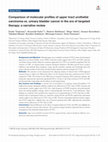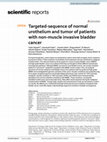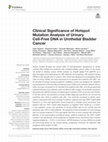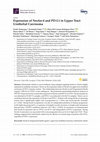Papers by EISUKE TOMIYAMA

International Journal of Molecular Sciences
Fucosylation is an oligosaccharide modification that plays an important role in immune response a... more Fucosylation is an oligosaccharide modification that plays an important role in immune response and malignancy, and specific fucosyltransferases (FUTs) catalyze the three types of fucosylations: core-type, Lewis type, and H type. FUTs regulate cancer proliferation, invasiveness, and resistance to chemotherapy by modifying the glycosylation of signaling receptors. Oligosaccharides on PD-1/PD-L1 proteins are specifically fucosylated, leading to functional modifications. Expression of FUTs is upregulated in renal cell carcinoma, bladder cancer, and prostate cancer. Aberrant fucosylation in prostate-specific antigen (PSA) could be used as a novel biomarker for prostate cancer. Furthermore, elucidation of the biological function of fucosylation could result in the development of novel therapeutic targets. Further studies are needed in the field of fucosylation glycobiology in urological malignancies.
Cancer Immunology, Immunotherapy, May 22, 2022
The effects of Abx administration on cancer-free prostates and serum testosterone levels, and the... more The effects of Abx administration on cancer-free prostates and serum testosterone levels, and the effects of gentamicin administration on HFD PCa mice.
Composition and energy values of control diet and high-fat diet

Translational Andrology and Urology
Background and Objective: Although upper tract urothelial carcinoma (UTUC) shares the histologica... more Background and Objective: Although upper tract urothelial carcinoma (UTUC) shares the histological appearance of urinary bladder cancer (UBC), molecular studies suggest that UTUC and UBC represent two distinct disease entities. However, treatment approaches for UTUC are virtually extrapolated from the evidence on UBC. As targeted drugs-immune-checkpoint inhibitors, fibroblast growth factor receptor inhibitors, and antibody-drug conjugates-target specific molecules, gaining more knowledge about the target-molecular profiles of each drug can help formulate optimal treatment strategies for UTUC. Methods: This narrative review summarized the subgroup analyses of clinical trials of FDA-approved targeted drugs to explore the differential effects of each targeted drug when administered for UTUC compared to UBC. We focused on the differences in mutation frequency, RNA expression subtype, and therapeutic target protein expressions (specifically PD-L1, Nectin-4, and Trop-2) between UTUC and UBC and discussed their relationship with the efficacy of each targeted drug.

Scientific Reports
During tumorigenesis, certain tissues are colonized by mutant clones with oncogenic driver mutati... more During tumorigenesis, certain tissues are colonized by mutant clones with oncogenic driver mutations as precancer lesions. These mutations can facilitate clonal expansion and may contribute to malignant transformation. The molecular features of low-grade non-muscle invasive bladder cancer (NMIBC) and high-grade bladder cancer are so distinct that they are thought to follow different evolutionary tumorigenesis pathways. Although NMIBC accounts for most bladder tumors, the somatic mutation patterns in “precancer” urothelium of patients with NMIBC remain unclear. Here, we analyzed specimens of normal urothelium and bladder tumors from patients with low-grade and high-grade NMIBC and investigated the genomic evolution of the cancer. Somatic mutations were analyzed using 50 oncogene-targeted sequences and droplet digital polymerase chain reaction for TERT promoter mutations. Somatic mutations in TERT promoter, FGFR3, and CDKN2A were characteristically identified in the normal urothelium ...

International Journal of Cancer
Western high‐fat diets (HFD) are regarded as a major risk factor for prostate cancer (PCa). Using... more Western high‐fat diets (HFD) are regarded as a major risk factor for prostate cancer (PCa). Using prostate‐specific Pten‐knockout mice as a PCa model, we previously reported that HFD promoted inflammatory PCa growth. The composition of the gut microbiota changes under the influence of diet exert various effects on the host through immunological mechanisms. Herein, we investigated the etiology of HFD‐induced inflammatory cancer growth and the involvement of the gut microbiome. The expression of Hdc, the gene responsible for histamine biosynthesis, and histamine levels were upregulated in large prostate tumors of HFD‐fed mice, and the number of mast cells increased around the tumor foci. Administration of fexofenadine, a histamine H1 receptor antagonist, suppressed tumor growth in HFD‐fed mice by reducing the number of myeloid‐derived suppressor cells and suppressing IL6/STAT3 signaling. HFD intake induced gut dysbiosis, resulting in the elevation of serum lipopolysaccharide (LPS) lev...

Cancer Science, 2022
Perioperative systemic chemotherapy improves the prognosis of upper tract urothelial carcinoma (U... more Perioperative systemic chemotherapy improves the prognosis of upper tract urothelial carcinoma (UTUC). The first objective of this study is to verify whether perioperative circulating tumor DNA (ctDNA) analysis using a pan-cancer gene panel and next-generation sequencing can identify patients with poor prognosis who require perioperative chemotherapy. Secondly, we will investigate whether ctDNA is useful for minimal residual disease (MRD) detection and treatment monitoring in UTUC. This study included fifty patients with untreated UTUC, including 43 cases of localized UTUC. We performed targeted ultradeep sequencing of plasma cfDNA and buffy coat DNA and whole-exome sequencing of cancer tissues, allowing exclusion of possible false positives. We attempted to stratify the prognosis according to the perioperative ctDNA levels in patients with localized UTUC. In patients with metastatic UTUC, ctDNA was evaluated before, during, and after systemic treatment. Twenty-three (46%) of 50 patients with untreated UTUC were ctDNA-positive, and 17 (40%) of 43 patients with localized UTUC were ctDNA-positive. Of the detected TP53 mutations, 19% were false-positive due to clonal hematopoiesis of indeterminate potential (CHIP). Among preoperative risk factors, only the preoperative ctDNA fraction>2% was a significant and independent risk factor associated with worse recurrence-free survival (RFS). Furthermore, the existence of ctDNA early point after the operation was significantly associated with worse RFS, suggesting the presence of MRD. ctDNA also showed potential as a real-time marker for systemic therapy in patients with metastatic UTUC. Detection of ctDNA may indicate potential metastasis and guide decisions of perioperative chemotherapy.
Journal of Urology, 2021
INTRODUCTION AND OBJECTIVE:Locally advanced or metastatic upper tract urothelial carcinoma (UTUC)... more INTRODUCTION AND OBJECTIVE:Locally advanced or metastatic upper tract urothelial carcinoma (UTUC) is a lethal disease with limited treatment options for patients who do not positively respond to pl...
Journal of Urology, 2020
INTRODUCTION AND OBJECTIVE:Immunotherapies such as immune checkpoint inhibitors (ICIs) have revol... more INTRODUCTION AND OBJECTIVE:Immunotherapies such as immune checkpoint inhibitors (ICIs) have revolutionized cancer treatment. However, the clinical effect of ICIs is still limited and identification...
Journal of Urology, 2019
INTRODUCTION AND OBJECTIVE:Regulatory T cells (Treg) play an important role in the construction o... more INTRODUCTION AND OBJECTIVE:Regulatory T cells (Treg) play an important role in the construction of immune status within the tumor microenvironment. On the other hand, in order to maximize the thera...

British Journal of Cancer, 2021
Altered prostate-specific antigen (PSA) glycosylation patterns can be useful biomarkers in detect... more Altered prostate-specific antigen (PSA) glycosylation patterns can be useful biomarkers in detecting high-grade prostate cancer (HGPC). The microfluidic immunoassay system can analyse α2,3-linked sialylated PSA (α2,3-Sia-PSA) and α1,6-linked fucosylated PSA (α1,6-Fuc-PSA) using different lectins, Mackkia amurensis agglutinin and Pholiota squarrosa lectin, respectively. Here, we investigated the diagnostic value of simultaneous analysis of α2,3-Sia-PSA and α1,6-Fuc-PSA for the detection of HGPC. Men with serum PSA levels of 4-20 ng/mL who underwent prostate biopsy were included. The model to predict HGPC (Gleason grade ≥2) was constructed by multivariate logistic regression analysis, in combination with α2,3-Sia-PSA and α1,6-Fuc-PSA (SF index). In the development cohort (n = 150), the SF index showed good discrimination for HGPC (area under the receiver-operating curve (AUC) 0.842; 95% confidence interval (CI) 0.782-0.903), compared to the single PSA test (AUC 0.632, 95% CI 0.543-0.721), α2,3-Sia-PSA (AUC 0.711, 95% CI 0.629-0.793) and α1,6-Fuc-PSA (AUC 0.738, 95% CI 0.657-0.819). Decision-curve analysis showed the superior benefit of the SF index. In the validation cohort (n = 57), the SF index showed good discrimination for HGPC (AUC 0.769, 95% CI 0.643-0.895). The SF index could differentiate HGPC, providing useful information for decision making for prostate biopsy in men with abnormal PSA levels.

Frontiers in Oncology, 2020
Recent studies showed the clinical utility of next-generation sequencing of urinary cell-free DNA... more Recent studies showed the clinical utility of next-generation sequencing of urinary cell-free DNA (cfDNA) from patients with urothelial bladder cancer (UBC). In this study, we aimed to develop urinary cfDNA analysis by droplet digital PCR (ddPCR) as a high-throughput and rapid assay for UBC detection and prognosis. We analyzed urinary cfDNA of 202 samples from 2 cohorts. Test cohort was designed for investigating clinical utility of urinary cfDNA, and was composed of 74 samples from patients with UBC, and 52 samples of benign hematuria patients. Validation cohort was designed for validation and assessment of clinical utility comparing urinary cfDNA with UroVysion (Abbott, Illinois, USA), and was composed of 40 samples from patients with UBC, and 36 prospectively collected samples from patients under surveillance after surgery for urothelial carcinoma. We performed ddPCR analysis of hotspot gene mutations (TERT promoter and FGFR3). In the test cohort, the sensitivity of urinary cfDNA diagnosis was 68.9% (51/74) and the specificity was 100% in patients with UBC. The sensitivity increased to 85.9% when used in conjunction with urine cytology. In addition, patients with high TERT C228T allele frequency (≥14%) had significantly worse prognosis in bladder tumor recurrence than patients with low TERT C228T allele frequency or negative TERT C228T (p = 0.0322). In the validation cohort, the sensitivity of urinary cfDNA was 57.5% (23/40) and the specificity was 100% in UBC patients. The sensitivity of the combination of urine cytology with our hotspot analysis (77.5%) was higher than that of urine cytology with UroVysion (68.9%). In the post-surgical surveillance group, patients positive for the TERT C228T mutation had significantly worse prognosis for bladder tumor recurrence than mutation negative patients (p < 0.001). In conclusion, ddPCR analysis of urinary cfDNA is a simple and promising assay for the clinical setting, surpassing UroVysion for detection and prognosis determination in UBC.
Journal of Urology, 2021
INTRODUCTION AND OBJECTIVE:High-fat diet (HFD) and resultant obesity are risks for prostate cance... more INTRODUCTION AND OBJECTIVE:High-fat diet (HFD) and resultant obesity are risks for prostate cancer (PCa). The gut microbiota changes with various environmental factors, including diet. The aim of t...
Journal of Urology, 2021
INTRODUCTION AND OBJECTIVE:The gut microbiota is involved in a variety of diseases that affect th... more INTRODUCTION AND OBJECTIVE:The gut microbiota is involved in a variety of diseases that affect the entire body. Diet and body size influence the gut microbiota and are important risk factors for pr...

International Journal of Urology, 2021
DOI: 10.1111/iju.14689 UTUC is a rare disease that accounts for 5–10% of all urothelial carcinoma... more DOI: 10.1111/iju.14689 UTUC is a rare disease that accounts for 5–10% of all urothelial carcinomas. Patients with UTUC often present with invasion or metastases when diagnosed and have a poorer prognosis than those with BCa. PD-L1 inhibitors have shown clinical efficacy for patients with advanced or metastatic urothelial carcinoma, especially those with PD-L1-positive tumors. To determine the suitability of PD-L1 inhibitors, it is important to identify patient populations with PD-L1-positive tumors. Recently, genetic profiling studies have shown that MIBCa can be classified into different molecular subtypes, which are used to design targeted treatments. In addition, immunohistochemical staining for GATA3 and CK5/6 is reportedly sufficient to determine molecular subtypes. The basal subtype shows a significant association with a high PD-L1-positive rate, suggesting that this subtype might be responsive to immunotherapy; however, the PD-L1 expression status in UTUC stratified by molecular subtypes is unknown. In the present study, we analyzed PD-L1-positive rates in the luminal (GATA3/CK5/6 ), basal (GATA3 /CK5/6) and double-negative (considered a p53-like or neuroendocrine-like subtype [GATA3 /CK5/6 ]) subtypes of UTUC. A UTUC-TMA was constructed with tumor samples, spotted in triplicate, obtained from 99 patients with non-metastatic UTUC who had undergone radical nephroureterectomy, as described previously. Appropriate approval was obtained from the local institutional review board before construction and use of the TMA, and written informed consent was obtained from all patients. The clinicopathological characteristics and outcomes of these patients are summarized in Table S1. TMA sections were stained using primary antibodies against GATA3 (1:200; L50-823; Biocare Medical, Pacheco, CA, USA), CK5/6 (1:100; D5/16B4; Sigma–Aldrich, St. Louis, MO, USA) and PD-L1 (1:100; E1L3N; Cell Signaling Technology, Danvers, MA, USA). The staining data for GATA3 and PD-L1 have been previously reported, but GATA3 was re-assessed using a new criterion. A cut-off of 20% positivity was used to classify cases as positive or negative for GATA3 (nuclear staining) and CK5/6 (cytoplasmic staining), as this cutoff best separates tumors into their molecular subtypes. Accordingly, each case was categorized into the luminal, basal or double-negative subtype, excluding double-positive cases, which have been reported to be exceptional, mainly in the luminal subtype. The extent of membranous PDL1 expression was also determined microscopically in each spot (0–100%). The average PD-L1 expression was calculated in each case, and a cut-off of 1% was used. The Kaplan–Meier method was used for determining survival rates, with a log-rank test for comparisons. Fisher’s exact test was used for evaluating the association between categorized variables. Representative expression patterns are shown in Figure 1a. Among the 99 patients with UTUC, GATA3 positivity was detected in 35 (35.4%), with CK5/6 positivity in 48 (48.5%). The luminal, basal and double-negative subtypes were detected in 26 (26.3%), 39 (39.4%) and 25 (25.3%) patients, respectively. Cancer-specific survival was significantly different among the three groups (P = 0.034; Fig. 1b). Notably, the basal subtype had a worse prognosis than the luminal subtype in our cohort. A total of 24 (24.2%) of the 99 samples were positive for PD-L1. PD-L1 positivity rates in the luminal, basal and double-negative subtypes were 19.2% (5/26), 23.1% (9/39) and 36.0% (9/25), respectively (Fig. 1c). There was no significant difference in PD-L1 positivity rates among each subtype (P = 0.398). This result was inconsistent with those in previous studies on MIBCa suggesting a high PD-L1-positivity rate in the basal subtype. Although this subtype of MIBCa is thought to benefit from immunotherapy, this might not be the case for UTUC. To date, studies reporting subtypes or PD-L1 expression status in urothelial carcinomas have focused mainly on BCa rather than UTUC. To the best of our knowledge, this is the first study to evaluate PD-L1 expression status among UTUC subtypes. In addition to immunohistochemical analysis, a large-scale genetic profiling study is required to validate the relationship between PD-L1 expression status and UTUC subtypes. The efficacy of PD-L1 inhibitors for each subtype is expected to be investigated in further clinical studies. In conclusion, we analyzed the

Cancer Science, 2021
We have found that intestinal bacteria and their metabolites, short‐chain fatty acids (SCFAs), pr... more We have found that intestinal bacteria and their metabolites, short‐chain fatty acids (SCFAs), promote cancer growth in prostate cancer (PCa) mouse models. To clarify the association between gut microbiota and PCa in humans, we analyzed the gut microbiota profiles of men with suspected PCa. One hundred and fifty‐two Japanese men undergoing prostate biopsies (96 with cancer and 56 without cancer) were included in the study and randomly divided into two cohorts: a discovery cohort (114 samples) and a test cohort (38 samples). The gut microbiota was compared between two groups, a high‐risk group (men with Grade group 2 or higher PCa) and a negative + low‐risk group (men with negative biopsy or Grade group 1 PCa), using 16S rRNA gene sequencing. The relative abundances of Rikenellaceae, Alistipes, and Lachnospira, all SCFA‐producing bacteria, were significantly increased in high‐risk group. In receiver operating characteristic curve analysis, the index calculated from the abundance of 1...

International Journal of Molecular Sciences, 2020
Enfortumab vedotin is a novel antibody–drug conjugate targeting Nectin-4, which is highly express... more Enfortumab vedotin is a novel antibody–drug conjugate targeting Nectin-4, which is highly expressed in urothelial carcinoma. However, the expression status of Nectin-4 in upper tract urothelial carcinoma (UTUC) remains unclear. The relationship between Nectin-4 and Programmed Death Ligand 1 (PD-L1) in UTUC is also ambiguous. We performed immunohistochemical analysis of 99 UTUC tissue microarray to assess the expression of Nectin-4 and PD-L1 in UTUC. Nectin-4-positivity was detected in 65 (65.7%) samples, and PD-L1 was detected in 24 (24.2%) samples. There was no correlation between the expression of Nectin-4 and PD-L1. Patients with strong Nectin-4-expressing tumors had a significantly higher risk of progression (p = 0.031) and cancer-specific mortality (p = 0.036). Strong Nectin-4 expression was also an independent predictor of disease progression in the high-risk group (pT3 ≤ or presence of lymphovascular invasion or lymph node metastasis) (Hazard ratio, 3.32 [95% confidence inter...











Uploads
Papers by EISUKE TOMIYAMA